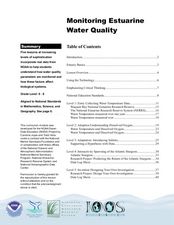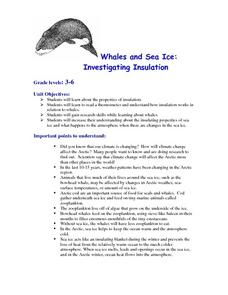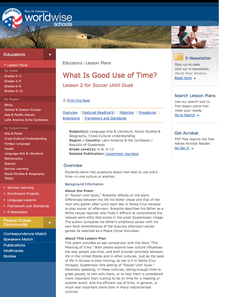Curated OER
Sharks At Risk Viewing Guide
Students complete a worksheet while viewing a film about sharks. They examine the reasons for overfishing of the oceans. They identify predator-prey relationships as well.
Curated OER
Busy Otters
Students prepare for a trip to an aquarium by identifying otters, their body parts and behaviors as they read "Pup's Supper", do an otter pantomime and make a puppet. After their field trip, they complete a Venn Diagram of Otter behaviors.
Curated OER
A Sea-nic Perspective
Students brainstorm topics related to the health of our world's oceans. They create presentations about specific issues affecting oceans for display in a classroom exhibit. They write letters of invitation to guests to view the exhibit.
Curated OER
Food Chains & Food Webs
Tenth graders examine how energy is lost through different trophic levels. In this trophism instructional activity students construct a food web and view a video.
Curated OER
Japanese Scientists Photograph Giant Squid
Students read and discuss a news article about scientists capturing first-ever photos of a giant squid in its habitat. They answer comprehension questions, write a journal entry from the scientists point of view, and analyze a giant...
Curated OER
This Old Tubeworm
Students plot data to construct and interpret a graph about vestimentiferans at cold-seep sites in the Gulf of Mexico. In this deep sea lesson, students plot data provided for the growth of tubeworms. They use the graphs to determine...
Curated OER
Boom and Bust
Students investigate commercial fishery. In this fishery lesson, students describe stages in commercial fishery, interpret data and predict when a fisher stock is showing signs of overexploitation.
Curated OER
GPS Treasure Hunt
Students explore geography by participating in a treasure hunt activity. In this Global Positioning System lesson, students define the terms latitude and longitude while utilizing an electronic GPS device. Students view a PowerPoint...
Curated OER
The Good, The Bad, and the Arctic
High schoolers investigate the social, economic and environmental consequences that might result from Arctic climate change. Students identify and discuss at least three consequences.
Curated OER
Design a Deep- Sea Vertebrate or Invertebrate
Learners design a deep-sea animal. In this research based lesson, students research and design a vertebrate or invertebrate that lives in a methane hydrate habitat. They compile a class chart of the adaptations animals have in this...
Curated OER
Monitoring Estuarine Water Quality
Learners analyze water quality data from real data. In this environmental science lesson, students examine how salinity and dissolved oxygen affect the living organisms in the estuary. They interpret graphs to support or disprove a...
Curated OER
Earth Day
Young scholars participate in activities that familiarize them with what Earth Day is, why it is important, and why it is a celebration.
Curated OER
Whales and Sea Ice: Investigating Insulation
Students investigate the properties of insulation as it relates to whales and sea ice. They research whales and examine the atmospheric changes that occur when there are changes in sea ice.
Curated OER
Environmental Problems and Solutions
In this environmental problems and solutions worksheet, students are given a list of 25 environmental problems. They match them with a given solution and paste the matching pairs to a piece of construction paper.
Curated OER
What Is Good Use of Time?
Students delve into questions about how best to use one's time-in one culture or another. They explore the kinds of choices students will make about their use of time and consider the statement: "We are shaped by the values of the...
Curated OER
Teaching Lewis and Clark: Tribal Cultures and Homelands
Students examine the attributes of the tribes that inhabited the Columbia River Basin. In this Lewis and Clark lesson, students participate in a classroom simulation that requires them to participate in a seasonal round, in which they...
Curated OER
Cutt-Off Genes
Students explore how gene sequence analysis can be used to examine phylogenetic similarities of different organisms. Students work in groups to simulate a gel electrophoresis separation of fragments using poster board to create their gel.
Curated OER
Who's Your Neighbor?
Students recognize and identify some of the fauna groups found in deep-sea coral reef communities. They describe common feeding strategies used by benthic animals in deep-sea coral reef communities.Students be able
Curated OER
AFRICAN-AMERICAN HOMESTEADERS
Students analyze the factors that inhibited and fostered African American attempts to improve their lives during Reconstruction, the role of class, race, gender, and religion in western communities, and the challenges diverse people...
Curated OER
Climate Change
Young scholars discuss problems associated with a world climate change. They examine how animals would be affected if the world heated up.
Curated OER
The Gulf of Maine
Students examine the effect of limiting factors, especially when it comes to human beings. They examine data from the Gulf of Maine area.
Curated OER
Habitats and Adaptations
Young scholars research and describe the habitat and adaptations of a reef animal. After the student is assigned a habitat, they design and draw a cresture adapted to eat each food and to live in each habitat.
Curated OER
Dig Into Ireland
Students explore environments and wildlife of Ireland to find out how they were formed, and how they helped form Irish culture. Students research online to determine connections between present elements in Irish culture and wildlife and...
Curated OER
Let's Go To Mexico
Students are able to use the Internet to conduct research. They research Mexican culture and traditions. Students compare and contrast Mexican and U.S. food and clothing. They convert United States currency to Mexican pesos. Students...

























